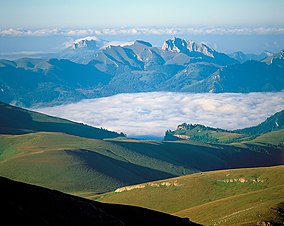Caucasus Nature Reserve
| Caucasus Nature Reserve | |
|---|---|
|
Russian: Кавказский им. Х.Г. Шапошникова заповедник (Also: Caucasus, Kavkasky) |
|
|
IUCN category Ia (strict nature reserve)
|
|

Caucasus Zapovednik
|
|
| Location of Reserve | |
| Location | Krasnodar Krai |
| Nearest city | Sochi |
| Coordinates | 43°50′10″N 40°24′3″E / 43.83611°N 40.40083°ECoordinates: 43°50′10″N 40°24′3″E / 43.83611°N 40.40083°E |
| Area | 280,335 ha (692,720 acres) |
| Established | 1924 |
| Governing body | Ministry of Natural Resources and Environment (Russia) |
| Website | http://kgpbz.ru/ |
Caucasus Nature Reserve (Russian: Кавказский им. Х.Г. Шапошникова заповедник) (also Caucasus, or Kavkasky) is a Russian 'zapovednik' (strict ecological reserve) covering a heavily mountainous section of the Northwest Caucasus Mountains. It is the largest and oldest in the territory of specially protected natural area in the Caucasus, having been created in 1924 as the Caucasian Bison Reserve. In 1979, the site was named a UNESCO Biosphere Reserve, and in 1999 included in a UNESCO World Heritage Site. In 2008 it was officially renamed after Khachatur (Christopher) G. Shaposhnikova the biologist who founded the reserve. The area is situated in the Mostovsky District of Krasnodar Krai, covering an area of 280,335 ha (1,082.38 sq mi).
The Caucasus Reserve protects mountainous terrain. It is bounded on the south by Sochi National Park and the ridge of the Caucasus bordering on the Republic of Abkhazia. Altitudes range from 260 meters to 3,360 meters.
Caucasus is located in the Caucasus mixed forests eco-region. This eco-region is located along the Caucasus Mountains between the Black Sea and the Caspian Sea. The region has one of the highest levels of species endemism and diversity in the world: 23% of vascular species, and 10% of vertebrates.
The climate of Caucasus is Humid subtropical climate (Köppen climate classification Cfa), a climate characterized by hot, humid summers and cool winters. In the Caucasus Reserve, however, the high range of altitudes leads to severe tundra climate at the highest elevations. The average temperature in January is 4.3 C degrees, in July it is 21 C degrees. Average annual precipitation is 700 - 1,200 mm.
The plant life of the reserve is characterized by high biodiversity, reflecting the position of the site at the meeting point of several floral zones (temperate and sub-tropical) and with the widest range of altitude zones (from forested river valleys to mountain top tundra). The reserve has recorded 1,500 species of vascular plants, of which 20% are endemic to the Caucasus. Most of the territory is forested, with sub-alpine and alpine meadows at the higher elevations. The coniferous yew trees in the Khosta sector can reach an age of over 2,000 years. The typical trees of the lower elevations are oak and alder. The upper forest levels are more dark fir and spruce. The rest of the Caucasus Reserve differ from those of northern Europe by the presence of vines.
...
Wikipedia

